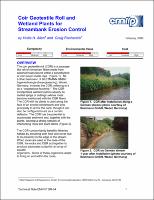Please use this identifier to cite or link to this item:
https://hdl.handle.net/11681/3980Full metadata record
| DC Field | Value | Language |
|---|---|---|
| dc.contributor.author | Allen, Hollis H. | en_US |
| dc.contributor.author | Fischenich, J. Craig, 1962- | en_US |
| dc.creator | Environmental Laboratory (U.S.) | en_US |
| dc.creator | Ecosystem Management and Restoration Research Program (U.S.) | en_US |
| dc.date.accessioned | 2016-03-16T16:16:04Z | en_US |
| dc.date.available | 2016-03-16T16:16:04Z | en_US |
| dc.date.issued | 2000-02 | en_US |
| dc.identifier.govdoc | Technical Note EMRRP SR-04 | en_US |
| dc.identifier.uri | http://hdl.handle.net/11681/3980 | en_US |
| dc.description | Technical Note | en_US |
| dc.description.abstract | The coir geotextile roll (CGR) is a sausage like roll of nonwoven fibers made from coconut husks bound within a polyethylene or coir woven mesh rope (Figure 1). Mr. Lothar Bestmann of BESTMANN GMBH Ingenierbiologie (bioengineering), Wedel, Germany, invented the CGR, referring to it as a “vegetations-faschine." The CGR incorporates wetland plants (usually as rooted sprigs or cuttings) whose roots become interlocked with the CGR fibers. The CGR with its plants is used along the face of an eroded streambank and acts principally to armor the bank, though it can also be configured to act as a current deflector. The CGR has the potential to accumulate sediment and, together with the plants, develop a strong network of interlocking roots and plant stems (Figure 2). The CGR concomitantly benefits fisheries habitat by providing both food and cover due to its proximity to the edge of the stream. When rocks are used at the base of the CGR, the rocks and CGR act together to produce substrates suited for an array of aquatic organisms. Some of these organisms adapt to living on and within the rocks, and some attach themselves to the plants, which they may also use for food. The CGR can improve water quality and aesthetics. Plants within the CGR, especially emergent aquatic plants, such as bulrush (Scirpus spp.) and sedges (Carex spp.), will assimilate contaminants within the water column, though the total mass uptake may be small. The CGR can also improve non-point pollution control by intercepting sediment and associated pollutants coming into the stream from overbank areas. Plants within the CGR can be somewhat tailored to provide color, texture, and other attributes that add a pleasant, landscaped appearance. Such plants include blueflag (Iris versicolor, a wetland wild iris with a blue flower), pickerelweed (Pontedaria cordata), monkey flower (Mimulus ringens), and cardinal flower (Lobelia cardinalis). | en_US |
| dc.description.sponsorship | Ecosystem Management and Restoration Research Program (U.S.) | en_US |
| dc.format.extent | 8 pages/0.98 MBs | en_US |
| dc.format.medium | PDF/A | en_US |
| dc.language.iso | en_US | en_US |
| dc.publisher | Engineer Research and Development Center (U.S.) | en_US |
| dc.relation | http://acwc.sdp.sirsi.net/client/en_US/search/asset/1004279 | en_US |
| dc.relation.ispartofseries | Technical Note (Ecosystem Management and Restoration Research Program (U.S.)) ; no. Technical Note EMRRP SR-04 | en_US |
| dc.rights | Approved for public release; distribution is unlimited | en_US |
| dc.source | This Digital Resources was created in Microsoft Word and Adobe Acrobat | en_US |
| dc.subject | Wetland plants | en_US |
| dc.subject | Streambank planting | en_US |
| dc.subject | Geotextiles | en_US |
| dc.subject | Soil conservation | en_US |
| dc.title | Coir geotextile roll and wetland plants for streambank erosion control | en_US |
| dc.type | Report | en_US |
| Appears in Collections: | Technical Note | |
Files in This Item:
| File | Description | Size | Format | |
|---|---|---|---|---|
| ERDC-TN-EMRRP-SR-04.pdf | 1.01 MB | Adobe PDF |  View/Open |